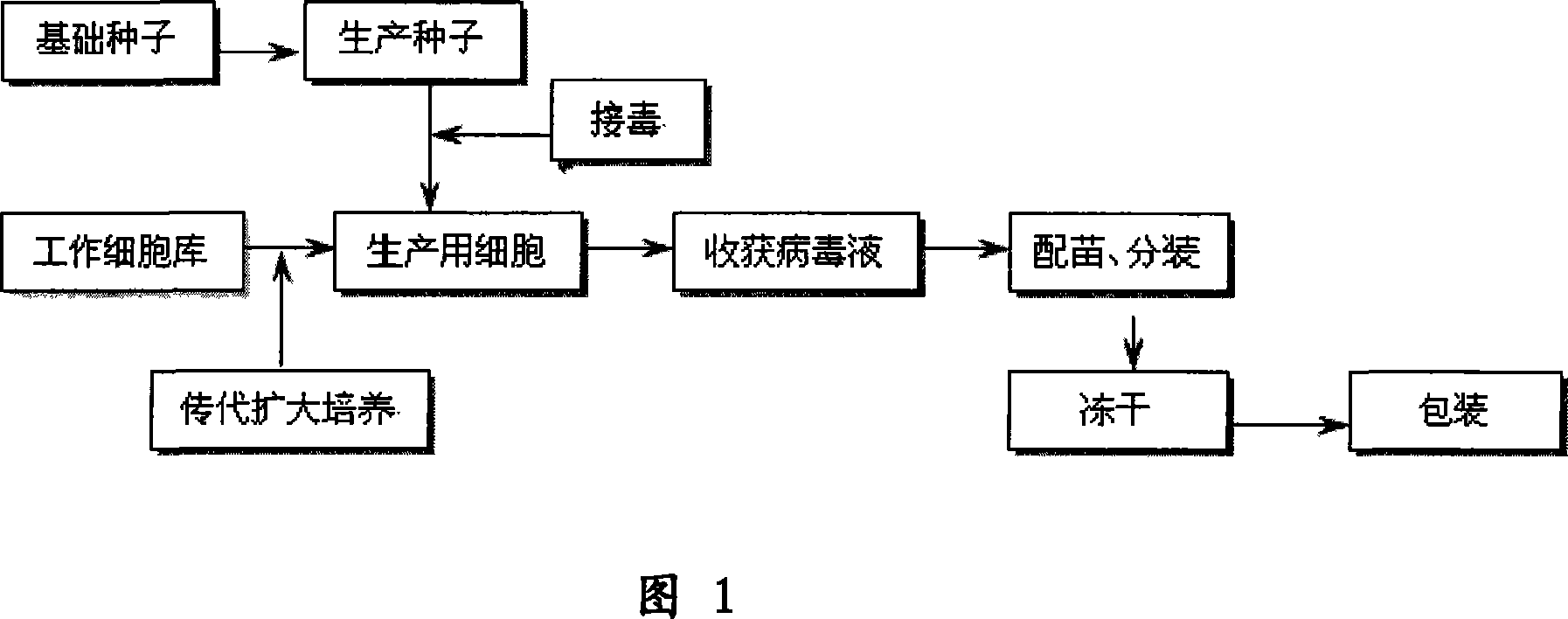Method for producing swine fever live vaccine with cell line
A live swine fever vaccine and cell line technology, which can be used in pharmaceutical formulations, medical preparations containing active ingredients, antibody medical ingredients, etc., can solve the difficulties in improving vaccine production and efficacy, exogenous virus contamination of cells, and toxin-producing drops It can achieve good economic benefits and application prospects, high virus content, and solve the effect of exogenous pathogen contamination of cattle.
- Summary
- Abstract
- Description
- Claims
- Application Information
AI Technical Summary
Problems solved by technology
Method used
Image
Examples
Embodiment 1
[0027] (1) Selection of cells for seedling preparation: select porcine testis (ST) cell line for use;
[0028] (2) Passage and culture of cells for seedling production: ST cell line is digested and passed by EDTA-trypsin cell dispersion liquid, and then cultured with cell growth medium at 36°C. When a good monolayer is formed, it is used for continued passage or inoculation Virus;
[0029] (3) Propagation of cytotoxic species: use cell maintenance solution to make 0.3% virus suspension from fresh spleen venom, inoculate a single layer of well-grown ST cell line, and continue culturing at 36°C. Harvest and change the medium every 4 days, take the second harvest and third harvest of cell culture venom as the poisonous species for production;
[0030] Identification of cytotoxic species: The identification of cytotoxic species fully complies with the standard of attenuated strains of classical swine fever, which is safe for pigs and has no side effects. Each 1ml of cytotoxic spe...
Embodiment 2
[0038] (1) Selection of cells for seedling preparation: select porcine kidney (PK15) cell line for use;
[0039] (2) Passage and culture of cells for seedling production: PK15 cell line was digested and passed by EDTA-trypsin cell dispersion liquid, and continued to culture at 37°C with cell growth liquid. When a good monolayer was formed, it was used for continued passage or virus inoculation;
[0040] (3) Propagation of cytotoxic species: use cell maintenance solution to make 0.4% virus suspension from fresh spleen poison, inoculate a single layer of well-growing PK15 cell line, and place at 37° C. to continue culturing. Harvest and change the medium every 5 days, take the second harvest and third harvest of cell culture venom as the poisonous species for production;
[0041] Identification of cytotoxic species: The identification of cytotoxic species fully complies with the standard of attenuated strains of classical swine fever, which is safe for pigs and has no side effec...
Embodiment 3
[0049] (1) Selection of cells for seedling preparation: select porcine kidney (IBRS-2) cell line for use;
[0050] (2) Passage and culture of cells for seedling production: IBRS-2 cell line was digested and passed by EDTA-trypsin cell dispersion solution, and continued to culture at 37°C with cell growth medium. When a good monolayer was formed, it was used for continued passage or inoculation Virus;
[0051] (3) Propagation of cytotoxic species: use cell maintenance solution to make 0.5% virus suspension from fresh spleen venom, inoculate a single layer of well-growing IBRS-2 cell line, and place it at 37°C to continue culturing. Harvest and change the medium every 4 days, take the second harvest and third harvest of cell culture venom as the poisonous species for production;
[0052] Identification of cytotoxic species: The identification of cytotoxic species fully complies with the standard of attenuated strains of classical swine fever, which is safe for pigs and has no s...
PUM
 Login to View More
Login to View More Abstract
Description
Claims
Application Information
 Login to View More
Login to View More - R&D
- Intellectual Property
- Life Sciences
- Materials
- Tech Scout
- Unparalleled Data Quality
- Higher Quality Content
- 60% Fewer Hallucinations
Browse by: Latest US Patents, China's latest patents, Technical Efficacy Thesaurus, Application Domain, Technology Topic, Popular Technical Reports.
© 2025 PatSnap. All rights reserved.Legal|Privacy policy|Modern Slavery Act Transparency Statement|Sitemap|About US| Contact US: help@patsnap.com

